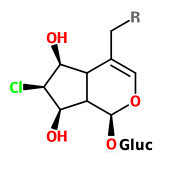Mentzelia angurate Weigend - syn. Mentzelia cordifolia Dombey; Mentzelia scabra Kunth subsp. grandiflora (G.Don) - Loasaceae - angurate, Angurate, Herzblatt
Much-branched subshrub, 30-60cm tall, native to the Andes of Peru; twig bark pale to greyish brown, strongly exfoliating; leaves subsessile or shortly petiolated, hispid, ovate, shallowly and irregularly lobed or just deeply serrate, base subcordate to subcuneate, 2-5cm long and 2-3cm broad; inflorescence frondose, lax, widely
branched; flowers with calyx tube subglobose, petals obovate, bright orange, funnel-forming, 2-2.5; fruit a globose capsule; 6-8mm diam.; sedds small, brown. „The specific epithet ‘angurate’ or ‘anguaraté’ represents the local name of Mentzelia in central Peru.“
[Systematics of the genus Mentzelia (Loasaceae) in South America 1., Weigend, M., Annals of the Missouri Botanical Garden, 94(3), 2007, 655-689]
 7-chlorodeutziol (R=H), mentzefoliol (R=OH); glycosylmentzefoliol (R=Glucose)
7-chlorodeutziol (R=H), mentzefoliol (R=OH); glycosylmentzefoliol (R=Glucose)
A decoction of the leaves with twigs (Anguraté, Mentzelia herba) is traditionally used in mild gastrointestinal disorders such as indigestion, bloating, occasional heartburn, for gastric cramps, also after drinking alcohol. The infusion is used as a traditional medicine, exclusively based upon long-standing experience of application. Compounds found in the leaves include bitter tasting iridoids like mentzeloside and mentzefoliol, 7-chlorodeutziol, cumarines like scopoletin, flavanoids, and traces of an essential oil.
[Wolfgang Blaschek ed., Wichtl - Teedrogen und Phytopharmaka: Ein Handbuch für die Praxis, 2015, 427-428]

Mentzelia angurate (C) Alsitan GmbH
